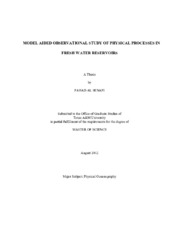| dc.description.abstract | The aim of this study is to compare observational data to data simulated by a one dimensional model. Observational data collected from January to July 2006 at Lake Whitney, Texas, included water current velocities from an Acoustic Doppler Current Profiler, and an Acoustic Doppler Velocimeter from which shear stress, turbulent kinetic energy dissipation rates, and turbulence kinetic energy were computed using several methods. Numerical model experiments, forced by the surface heat and momentum fluxes, velocity profiles, and temperature profiles were conducted to simulate the development of the turbulence parameters. Two equation models, k-epsilon and k-kl, were used to find which model best describes the observed physical processes (turbulence kinetic energy, turbulent kinetic energy dissipation rate and velocity variances).
The combined observational and simulated results show a change in stratification levels that consequently leads to variations in turbulent kinetic energy dissipation rate, turbulent kinetic energy, and the velocity variances. In order to investigate the accuracy of the model, we quantitatively compared these parameters to estimates from the observed data in the bottom boundary layer. In general, the model and observational data agree well for the three parameters, with the exception of some time periods, during which the model prediction differed from the observed. This was at times when the Acoustic Doppler Velocimeter measurements were at the noise level of the instrument. Overall, the k-kl model simulation results appear to be closer to the observational results during the weakly and strongly stratified periods than the k-epsilon model. | en |


